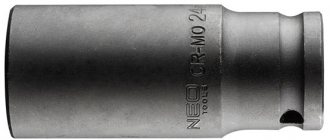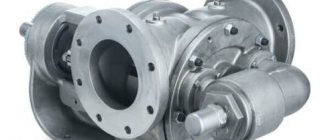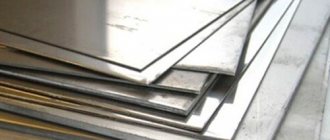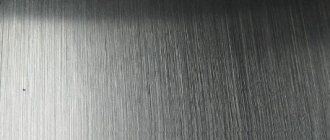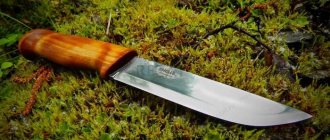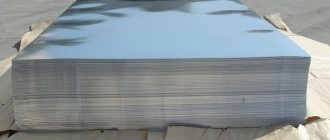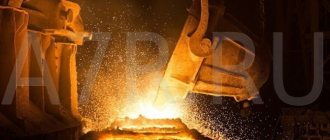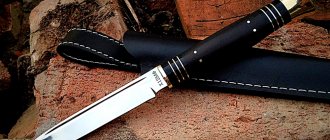Characteristics of steel grade AISI 430 / SS 430
| Standard | ASTM A182 - Standard Specification for Forged or Rolled Pipe Flanges, Forged Fittings, Valves, and Alloy and Stainless Steel Parts for High Temperature Service ASTM A240 - Standard Specification for Chrome- and Nickel-Chrome, Chrome- and Manganese-Nickel Stainless Steels for Plate, Sheet, and Strip for Pressure Vessels and General Applications ASTM A268 - Standard Specification for Seamless and Welded Ferritic and Martensitic Stainless Steel Pipe for General Applications ASTM A276 - Standard Specification for Fabricated, Unhot or Cold Processed Bars and Blooms, Other than Forged (Recycled) Bars ASTM A314 - Standard Specification Covers Stainless Steel Billets and Bars for Forging Only ASTM A479 - Standard Specification for Stainless Steel Rods and Sections for Boilers and Other Pressure Vessels | ||||||
| Classification | Stainless Ferritic Steel | ||||||
| Application | Sheets, coils, rails, pressure vessels | ||||||
| Other names | UNS | S43000 | |||||
| USA (ASTM A182) | Forged or rolled flanges | A182 F430 | |||||
| USA (ASTM A240) | Flat rolled products | A240 Type 430 | |||||
| USA (ASTM A268) | Seamless and welded pipes | A268 TP430 | |||||
| USA (ASTM A276) | Rods and profiles | A276 Type 430 | |||||
| USA (ASTM A314) | Blanks for forging | A314 430 | |||||
| USA (ASTM A473) | Stampings | A473 430 | |||||
| USA (ASTM A479) | Rods and profiles for boilers and vessels | A479 430 | |||||
| USA (ASTM A580) | Stainless steel wire | A580 Type 430 | |||||
AISI 430 steel is the most popular of the corrosion-resistant ferritic steels intended for general use. It has good properties, characteristics, ease of processing, high resistance to intercrystalline corrosion and oxidation at high temperatures.
Analogue in chemical composition
The domestic grade 12x17 has become an analogue in terms of characteristics for AISI 430 stainless steel of the chemical type
However, it is important to note here that this product is only the closest in composition. The difference between AISI and domestic raw materials is quite large and is as follows
The amount of carbon in 430 is very, very low, eliminating the need to stabilize the steel with titanium. In percentage terms, carbon indicators are approximately 0.002-0.035%. This proportion of the total mass guarantees the complete absence of intergranular corrosion at elevated temperatures. Intensive formation of carbides will occur only when the temperature passes 1000 degrees Celsius. In addition, the low amount of carbon ensures excellent weldability of the material. Another difference between the domestic analogue for AISI 430 is that at temperatures from 500 to 800 degrees there is insensitivity to intercrystalline destruction. The main advantage of 430 is that it better resists chloride pressure cracking.
Mechanical properties of AISI 430 material
| Ultimate strength (temporary tensile strength), min., MPa | 450 |
| Yield strength, 0.2%, MPa | 205 |
| Rockwell hardness, HRB max. | 88 |
| Brinell hardness, HB type. | 160 |
| Magnetic properties | Ferromagnetic |
| Elongation, min., % | 22 |
Corrosion of metal
In sulfuric acid: when the concentration of sulfuric acid increases above 55%, corrosion of iron is observed. In 95-98 percent sulfuric acid at normal temperature, chromium steels (with a chromium content of about 17%) with a small addition of molybdenum have good resistance.
In nitric acid: low-carbon steels are not sufficiently stable in nitric acid solutions. When the HNO3 concentration increases to 35 - 40%, the corrosion of low-carbon steels in nitric acid increases. When the concentration of nitric acid is close to 100%, it becomes an oxidizing agent. During iron corrosion, the cathodic depolarizers are nitric acid molecules and nitrate ions. The stability of chromium steels in nitric acid increases if nickel and molybdenum are added to their composition.
In carbonic acid: the intensity of galvanic corrosion depends on the presence of oxygen, pH and the presence of carbonic acid. Oxygen corrosion of steel in the presence of carbonic acid proceeds practically without slowdown: the supply of oxygen to the metal surface does not decrease over time and corrosion under its influence continues at a constant rate. Despite the fact that corrosion with the release of hydrogen accounts for only 2.5 - 4% of the total destruction rate, most cases of corrosion of steel equipment are caused by it, since the presence of carbonic acid creates conditions favorable to the occurrence of oxygen corrosion.
Performance at elevated temperatures
| Temperature, °C | 300 | 400 | 550 | 650 | 750 |
| Tensile strength, MPa | 450 | 430 | 220 | 120 | 50 |
| Temperature, °C | 550 | 600 | 650 | 700 | 750 |
| Yield strength, MPa | 50 | 30 | 15 | 5 | 3 |
Corrosion resistance in acidic environments
| Temperature, °C | 20 | 80 | ||||||||||
| Concentration, % by weight | 1 | 5 | 10 | 20 | 80 | 100 | 1 | 5 | 10 | 20 | 80 | 100 |
| Sulfuric acid | 2 | 2 | 2 | 2 | 2 | 1 | 2 | 2 | 2 | 2 | 2 | 2 |
| Phosphoric acid | 0 | 0 | 2 | 2 | 1 | 0 | 0 | 0 | 2 | 2 | 1 | 1 |
| Nitric acid | 0 | 0 | 0 | 0 | 1 | 2 | 0 | 0 | 0 | 1 | 1 | 2 |
| Formic acid | 0 | 0 | 1 | 1 | 1 | 0 | 0 | 2 | 2 | 2 | 2 | 0 |
0
= high degree of protection (corrosion rate does not exceed 100 mm/year);
1
= partial protection (corrosion rate ranges from 100m to 1000 mm/year);
2
= no protection (corrosion rate exceeds 1000 mm/year).
Types of stainless steel
Stainless steel is an attractive material for use in modern industry. It consists of iron and chromium impurities.
Also, other elements are added to the mixture for the production of stainless steel, which are presented:
- nickel,
- niobium,
- molybdenum,
- titanium.
They are necessary for the material to acquire its physical and chemical qualities and become more durable.
Thanks to the mixture of iron and other elements, a material is created that can resist corrosion. Depending on the proportionality of the added elements, the stainless material becomes durable and can withstand even high temperatures. Due to its ductility, stainless steel is used in a wide variety of industries.
Iron itself becomes rusty quite quickly. If you mix it with chromium and other elements, an invisible film is formed on its surface, which prevents the flow of oxygen to it. As a result, no oxidation occurs. This layer is quite durable. Which makes the material more resistant to the formation of cracks, dents and many other defects. Steel can repair itself over time.
Scope of application
AISI 430 steel is widely used:
- In the chemical and petroleum industries;
- In mechanical and automotive industry;
- In construction (roofing organization) and design;
- In the food and wine industry;
- In the production of equipment for heat exchangers;
- In the manufacture of furnace equipment;
- In the manufacture of household appliances, dishes, plumbing and kitchen equipment.
Unlike austenitic steel grades containing nickel, chromium grades, which include AISI 430, have low thermal expansion and increased thermal conductivity. High heat resistance allows the use of steel:
- In refrigeration towers;
- In cooling systems for food tanks (cooling with water, glycol, etc.)
It is not recommended to use AISI 430 steel in conditions of cryogenic temperatures and in the construction of structures that are subject to heavy loads.
Welding
AISI 430 / ss 430 stainless steel can be welded by any method. It would be optimal to use arc welding in inert gases.
Welding “from above” is recommended (the welding tool is located above the surface to be welded); the filler material can be 309L welding wire. It is also possible to use electrodes based on ferritic steel AISI 430, AISI 308, AISI 310, AISI 309 or AISI 312.
It is recommended to clean welds from scale mechanically or chemically and then passivate them.
Where can I order rectangular stainless steel pipes?
When ordering rolled metal, any buyer wants to be sure of the reliability of the supplier and the quality of the purchased products.
is just such a supplier, carefully protecting its reputation. We have been working in this market for a long time and know what nuances are important for most customers. Therefore, when ordering AISI 430 rectangular pipes and other types of rolled metal from us, you can rest assured that you will receive high-quality materials at the best price. By choosing as your main supplier, you receive benefits such as:
- wide range of products;
- full compliance with modern European and Russian standards;
- wholesale, small wholesale and retail supplies;
- the ability to order rectangular pipes AISI 430 and other rolled metal products with non-standard dimensions;
- transparent pricing policy;
- discounts and special terms of service for regular customers;
- delivery to all regions of the Russian Federation;
- fast execution of orders (due to the availability of product stocks in warehouses).
You can familiarize yourself with the assortment on the website, but if you have any questions, call us at a telephone number convenient for you. We have competent consultants who are ready to quickly answer any question about the characteristics of rolled metal, the availability of goods in warehouses and delivery features.
Chemical composition
Steel 430 is capable of maintaining its basic performance qualities in fairly aggressive environments. In some cases, the metal is used in environments with high sulfur concentrations. The chemical composition is represented by a combination of inexpensive components, due to which the cost of the material is significantly reduced. Other features include the following:
- The main component is iron, which is present in almost all metals.
- The second main component is considered to be carbon. Its concentration in the composition determines strength and other performance characteristics. In the case under consideration, the concentration indicator is 0.12%.
- The chemical composition is characterized by the inclusion of chromium, silicon and manganese.
- The composition includes other chemical elements, the concentration of which is only a few fractions of a percent. These include harmful impurities, which reduce the performance characteristics of the material.
Chemical composition of AISI 430 steel
The rather high concentration of carbon determines that AISI 430 is characterized by high strength and hardness.
Basic information
430 grade steel is a stainless alloy. Currently, this general purpose corrosion-resistant ferritic chromium steel is very widely used. In short, the AISI 430, the Russian analogue of which is 08x17T, has the following main characteristics:
- The strength and mechanical properties of this material are very high.
- Increased resistance to corrosion, including atmospheric corrosion. Such indicators of this parameter are due to the fact that the composition contains a fairly high content of chromium and very low carbon.
- The level of processing of this steel is also very high. Excellent plastic deformability is observed, the alloy lends itself well to stamping, drawing, etc.
As mentioned earlier, the Russian analogue of AISI 430 is steel 08x17T, but a reservation should be made here. The first option is not only an analogue, it is considered an improved version. Technical requirements for the second group of raw materials are established by GOST 5632-72
It is also worth paying attention to the fact that the 08x17T brand, in turn, is a substitute for such materials as 12Х18Н10Т and 12Х18Н9Т
Cons of carbon steel knives
When it comes to shortcomings, they include:
- Low resistance to corrosion. Because of this, very often dark spots and rust can appear on the surface, even when you have not been in contact with water for a long time.
- When it comes to sharpening knives, it is a labor-intensive and time-consuming process. For this purpose, special devices are used, which are sold in specialized stores. If you sharpen a knife using field conditions, you will simply ruin the cutting edge.
- Many people are faced with the fact that the knife can come into contact with an acidic environment, which is very often found in foods. As a result, the dish will acquire the taste of iron, and the knife will collect the smell of the products you worked with. And in this case, even after a long wash, you will not completely remove this smell.
- It must be remembered that the carbon in the composition makes the knife more fragile. That is why it is better to handle it more carefully.
- This material is inferior to many, and therefore is not used almost anywhere.
As you can see, there are also quite serious disadvantages
Therefore, when choosing, you need to pay attention to them and draw conclusions before purchasing. If you take all this into account, you can get an excellent result without any problems.
general information
As you know, one of the main elements in the composition of such steel is carbon. It is contained by weight in amounts up to 2%. This allows for unsurpassed strength as well as good wear resistance. At the same time, a sharp cutting edge is maintained for a long time, even if you use the knife every day.
If you look a little into history, you can see that such steel was used until the 20th century. This is due to the fact that it was easy to make and also suitable for many items in the house. But over time, stainless steel completely replaced carbon steel from the production of knives. There is a good explanation for this because stainless steel has several major advantages. But in any case, you still need to look at the main advantages and disadvantages in order to better understand the whole concept of choice.
Heat treatment cycle[ | ]
The most common maraging steel in industry is N18K9M5T steel; the heat treatment process for it has been well studied. First, N18K9M5T steel is annealed at a temperature of about 820 °C for 15-30 minutes for thin sections and 1 hour for every 25 mm for thick sections to ensure the formation of a completely austenitic structure. This is followed by air cooling to room temperature with the formation of soft iron-nickel martensite. Subsequent aging (hardening of the precipitate) for about 3 hours at a temperature of 480 to 500 °C produces a fine dispersion of longitudinally displaced Ni3(X, Y) intermetallic phases left by the martensitic transformation, where X and Y are the solutes added for such precipitates. Over-processing reduces the stability of the primary, metastable coherent precipitates, leading to their dissolution and replacement by semi-coherent Laves phases such as Fe2Ni or Fe2Mo. Further excessive heat treatment causes martensite to decompose and revert to austenite.
In new compositions of maraging steels, other intermetallic stoichiometries and crystallographic relationships with the parent martensite were discovered, including the rhombohedral and bulk complex Ni50(X, Y, Z)50 (Ni50M50 in simplified notation).

